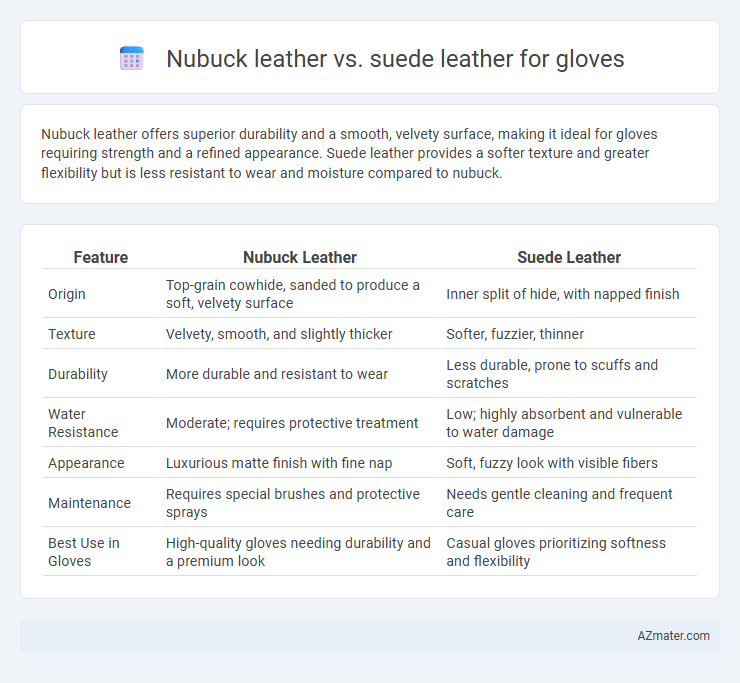Nubuck leather offers superior durability and a smooth, velvety surface, making it ideal for gloves requiring strength and a refined appearance. Suede leather provides a softer texture and greater flexibility but is less resistant to wear and moisture compared to nubuck.
Table of Comparison
| Feature | Nubuck Leather | Suede Leather |
|---|---|---|
| Origin | Top-grain cowhide, sanded to produce a soft, velvety surface | Inner split of hide, with napped finish |
| Texture | Velvety, smooth, and slightly thicker | Softer, fuzzier, thinner |
| Durability | More durable and resistant to wear | Less durable, prone to scuffs and scratches |
| Water Resistance | Moderate; requires protective treatment | Low; highly absorbent and vulnerable to water damage |
| Appearance | Luxurious matte finish with fine nap | Soft, fuzzy look with visible fibers |
| Maintenance | Requires special brushes and protective sprays | Needs gentle cleaning and frequent care |
| Best Use in Gloves | High-quality gloves needing durability and a premium look | Casual gloves prioritizing softness and flexibility |
Introduction to Nubuck and Suede Leather
Nubuck leather, made from the outer side of a hide, features a fine, velvety surface achieved by sanding the grain, offering durability and a smooth touch ideal for high-quality gloves. Suede leather, derived from the inner split of the hide, has a softer, fuzzy texture but is less resistant to wear and moisture compared to nubuck. Both materials provide comfort and style for gloves, yet nubuck's stronger grain structure affords better longevity and resistance to abrasion.
How Nubuck Leather is Made
Nubuck leather is made by sanding the outer surface of top-grain cowhide, creating a velvety, durable texture that is stronger and more resistant to wear than suede, which is made from the inner split of the hide. The sanding process enhances the natural grain, providing a smooth finish ideal for high-quality gloves that require both comfort and longevity. This manufacturing method results in nubuck gloves possessing superior water resistance and a refined appearance compared to the softer, more fragile suede gloves.
The Suede Leather Production Process
Suede leather is crafted by buffing the inner split of animal hides to create a soft, napped texture prized for glove manufacturing due to its flexibility and breathability. The production involves careful splitting of the hide to separate the grain layer, followed by sanding or brushing to achieve the characteristic velvet-like surface. This meticulous process enhances grip and comfort in suede gloves, distinguishing them from the smoother, more durable nubuck leather that is made by sanding the outer grain layer.
Texture and Appearance: Nubuck vs Suede
Nubuck leather features a fine-grain texture with a smooth, velvety surface achieved by sanding the outer layer, providing a polished and durable finish ideal for gloves requiring a refined look. Suede leather, created from the underside of the hide, exhibits a softer, fuzzier texture with a matte appearance, offering a more casual and flexible feel but less resistance to wear and stains. The distinct sanding process of nubuck results in a sturdier and more uniform texture, while suede's napped surface delivers enhanced breathability and comfort.
Durability and Strength Comparison
Nubuck leather offers superior durability and strength compared to suede due to its top-grain finish, making it more resistant to wear and tear in glove applications. Suede, made from the underside of the hide, is softer but less durable, prone to scuffing and damage under heavy use. For gloves requiring long-lasting performance and protection, nubuck leather provides a more robust and resilient material choice.
Comfort and Flexibility for Gloves
Nubuck leather offers enhanced comfort for gloves due to its fine, smooth surface created by sanding the outer grain, making it breathable and soft against the skin. Suede leather, made from the inner split of the hide, provides superior flexibility and a supple feel, allowing gloves to conform more easily to hand movements. Both materials balance comfort and flexibility, but Nubuck's durability and smooth texture often make it a preferred choice for premium glove comfort.
Maintenance and Care Requirements
Nubuck leather gloves require regular brushing with a soft bristle brush to maintain their smooth, velvety surface and should be protected from water and stains with specialized leather sprays. Suede leather gloves need gentle cleaning using a suede eraser or a damp cloth to remove dirt and stains, while avoiding excessive moisture to prevent damage or discoloration. Proper storage in a cool, dry place and avoiding direct heat sources are essential for preserving the texture and durability of both nubuck and suede gloves.
Water and Stain Resistance Differences
Nubuck leather exhibits superior water and stain resistance compared to suede due to its tighter grain and surface sanding technique, making it more durable for glove use in damp conditions. Suede's open, napped texture absorbs moisture and stains more readily, requiring additional waterproofing treatments for effective protection. Choosing nubuck gloves offers enhanced longevity and ease of maintenance in environments prone to exposure to water and dirt.
Cost and Value for Glove Buyers
Nubuck leather gloves offer higher durability and a smoother finish, often commanding a premium price compared to suede gloves, which are softer but less resistant to wear. For glove buyers, nubuck provides better long-term value due to its robustness and ability to maintain appearance over time. Suede gloves may be more affordable upfront but typically require more care and replacement, impacting overall cost-effectiveness.
Which Leather is Best for Gloves?
Nubuck leather offers superior durability and abrasion resistance compared to suede, making it the best choice for gloves that require long-lasting wear and protection. Its fine sanding process produces a smooth, velvety surface that withstands moisture better than the more porous, fuzzy texture of suede. For gloves combining comfort with robustness, Nubuck leather provides an optimal balance of softness and strength.

Infographic: Nubuck leather vs Suede leather for Glove
 azmater.com
azmater.com